
|
|
29 November, 2001
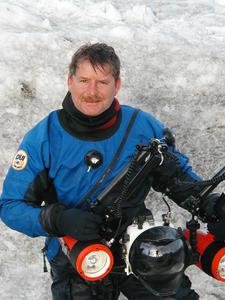
Team member: Dr. Steve Alexander with his underwater camera Dr. Steve Alexander, one of the scientists and divers on Dr. Sam Bowser's research team this season, is originally from Plymouth, England. Although he has lived in the United States for the past 15 years, he has spent the last three years sailing around the world with his wife, Jennifer. After completing his doctorate in Oceanography at the University of Wales at Swansea, he made the initial move to America to take a post doctorate position at Scripps Institution of Oceanography in La Jolla, California. It was this association with Scripps in 1986 that led Dr. Alexander to the Antarctic where he spent 14 months diving and carrying out research on Foraminifera (forams). He wintered over during this 1986-1987 summer/winter season, and returned to New Harbor during the austral (Southern Hemisphere) summers of 1987, 1988, 1989, 1991, 1993, and 2001. His fascination with the sea at an early age led him to pursue scuba diving at the age of 13, and this soon led to a passion for underwater photography. Dr. Alexander said photography opened his eyes to the world and enabled him to look at everything differently with a "new set of eyes". His photographs capture the unique and creative way in which he views the world; so it is no surprise that his photographs have been published in National Geographic Magazine, International Wildlife, and Skin Diver Magazine. Taking photos under the ice in Antarctica enables Dr. Alexander to share his experience by opening a "new" world beneath the ice for those who can't personally experience this extreme cold underwater environment.

While in Antarctica, Dr. Steve Alexander will dive under 12-feet of ice to collect forams, and will use his photography to bring back unique images of the underwater world. (Forams are one-celled organisms or protists, which are the focus of our study). This year, he is continuing research on how forams feed, as well as which marine organisms prey upon forams. In the 1980's, Dr. Alexander discovered evidence of forams parasitizing scallops by using their pseudopods to burrow through the thin shell to obtain nutrients. The pseudopods, which are thin strands of cytoplasm forming a branching web-like network, emerge from tiny holes in the forams and cover large areas of the sea floor. Forams may also use their pseudopodia to absorb nutrients from the water.
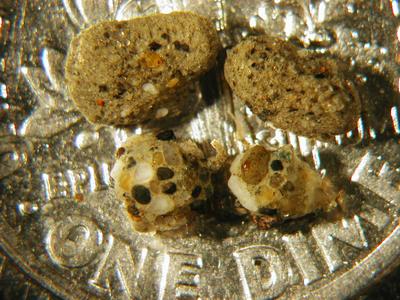
Dr. Alexander has a unique way of showcasing a subject in a photo. When I told him that I wanted a picture of forams for my journal, he put them on a dime as a "size" comparison.

The scallops next to the brittle star have small microscopic forams on their thin shells.

Dr. Alexander designed a "foram farm" to collect data to determine what percent of sediment is covered by pseudopod nets. Finding out what percent of sediment is covered by pseudopodial nets may help determine if forams control populations of some marine organisms. While at New Harbor, Dr. Alexander lowered his "farm", which consisted of eight glass petri dishes glued on a tray, into the ocean. Five forams were put in each dish and left at the bottom of the ocean for eight days. When Dr. Alexander slowly pulled it to the surface, he found that the pseudopodial nets were three or four times bigger than he thought they'd be. One net stretched 60 mm from a foram that was only 2 mm in diameter. This is 30 times the cell body width of the foram. Dr. Alexander wanted to check to see if putting forams in its own environment (in situ) rather than in a lab setting would provide more realistic results. The "foram farm" gave him the opportunity to test this hypothesis, and this is still being researched in the lab.
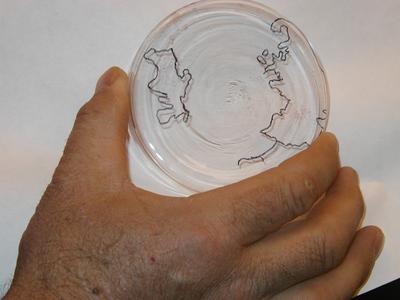
Dr. Alexander did a tracing of the pseudopodial nets on the petri dish. One net stretched 60 mm from a foram that was only 2 mm in diameter.
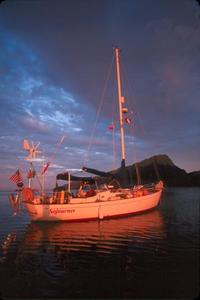
Dr. Alexander took this photo of his 35-foot sailboat, the Sojourner. He and his wife, Jennifer, have spent the last three years sailing around the world. Dr. Alexander is definitely the world traveler, beginning with his birth in Sri Lanka to the present, which has involved spending the last three years sailing around the world with his wife, Jennifer. Their aim is to record the beauty of the World's Oceans through the lens of a camera. Dr. Alexander and his wife left San Diego three years ago on a 35-foot sailboat and made their first major crossing of 30 days and 3000 miles across the Pacific Ocean. Prior to this passage, they had only10 hours and 60 miles experience of ocean sailing. After twenty-nine and a half days of sailing, they arrived in the Marquesas Islands, which is one of the most remote island groups in the Pacific. Then they sailed on to the Touamotusa, an archipelago made up of coral atolls, or low palm-fringed sandy islands, after which they traveled on to Tahiti, Moorea, Bora Bora, Cook Islands, and Nuie. Then they spent a year in Tonga to photograph and study Humpback whales before heading to Fiji. Dr. Alexander docked the boat in Fiji for the cyclone season before traveling to Antarctica. Dr. Alexander will be diving in Antarctica from October to February, after which his plans are to finish the world tour by way of Fiji, Australia, and then the Indian Ocean to Africa.
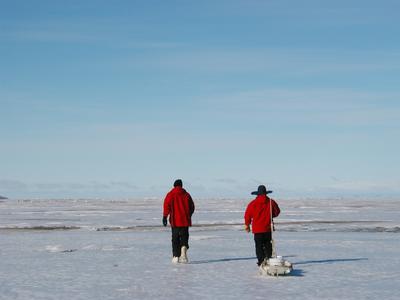
Somehow, this photo of Dr. Alexander pulling a sled across this vast white wilderness captures his views on living life, whether he is heading into the "unknown" across the sea ice in Antarctica, or sailing a 35-foot sailboat around the world. Dr. Alexander sold a successful computer business in California and convinced his wife to sell everything and undertake this photo journey around the world. He said that he didn't feel that it took as much "courage" to sail across the ocean, as it did to give up security to make huge life changes to live out his dream. He stated, " Most people let the fear of the unknown block their entire lives. The unknown is always scary; fear is not knowing what lies beyond. There is no reason not to live your dreams, if you have the courage to make the change, have a plan, and then work hard to prepare for it". Dr. Alexander lives life with a zest. His web page: www.worldoceans.com has wonderful photography of Antarctica, whales, exotic islands, and scuba diving. He shares this wonderful experience with his wife, Jen, whom I was so fortunate to meet at McMurdo. She took a job with Raytheon Polar Services (which takes care of logistics in Antarctica) in order to experience Antarctica.

I felt very fortunate to meet Dr. Alexander's wife, Jennifer, at McMurdo. This photo was taken in the Scott hut.
Contact the TEA in the field at
.
If you cannot connect through your browser, copy the
TEA's e-mail address in the "To:" line of
your favorite e-mail package.
|
